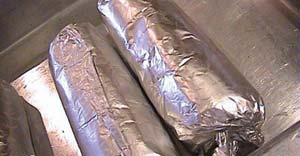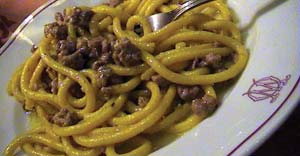Dare to cook hare
by Ann Oliver
Hunter 3
In my experience, shooters are a bit like fishermen. There is a lot of talk about what they bag, but so rarely do you see any of it arrive at your door. You can offer as many times as you like to cook anything they bring home and can be conceited enough to know you would probably do it better than they ever could, but no, all one hears is tall stories that are reminiscent of the fisherman’s ‘whopper stopper’.
I’ve been booked for a dinner for a well-known Adelaide Beef Steak and Burgundy Club and at least 50 per cent of these blokes are avid hunters with covetable gun collections. “Hare, no problems!” Well, I have heard this type of promise before and do not believe a word. The night before the dinner I am well into the preparations for the next day and of course the hare hasn’t appeared.
Frantic phone calls from the dinner’s organiser are really driving me nuts. He’s grumpy and cross, all the more so because when he promised the hare, my snooty retort was, “Yeah, I will believe it when I see it!” Then there is a phone call from an anonymous bloke, who says, “I’ve got the hare, they’re at my mum’s, I’ll deliver them in the morning.” I throw a foam box on the veranda. I have no intention of getting up at 6am to take delivery of something I am sure will never arrive.
At 8am I’ve had my morning coffee and regard the foam box, still in exactly the same position, with deep suspicion. “Shooter liar,” I think. Opening the door I kick the box and to my surprise it doesn’t move. I lift the lid and there are two of the freshest, most gorgeous looking hare I have ever seen. Instantly, I am ecstatically planning a few menu changes.
The saddles are stripped and will be seared, served with plump rare pigeon breasts I already have. I put the hind legs to one side for ragu and remove every last slither of meat from the forelegs and carcass, including the kidneys and livers, and turn them into sausages. No mucking around putting it into skins. Wrapped in baking paper and tightly twisted up with foil, they go in the oven for the last 15 minutes of the potatoes and rest for another five or ten while everything is served up.
The glaze is rich flavoured with crushed junipers and pepper, plenty of red wine, quince syrup and old balsamic. There will be crunchy roast potatoes, made with potatoes for mashing potatoes so they have deep, flaky, crispy edges. It will all be a perfect match for the ten-year-old shiraz it is to be served with.
Twelve hours later it is on the table and the sighs of pure pleasure make all the angst and effort worth it. I’ve forgiven the bloody shooters for messing me around and could almost kiss them for giving me the pleasure of cooking such a great meal.
Skinless Hare Sausages (main course for 2, entrée for 4)
For every 500g of hare meat, finely chopped, boneless and sinew free,
you will need:
 250g coarsely minced pork back fat
250g coarsely minced pork back fat- 100g shallots, peeled and finely chopped
- 50ml extra virgin olive oil
- Small handful parsley, stalked and roughly chopped
- 3 sprigs of thyme, leafed and finely chopped
- 5g sea salt
- 2.5g black pepper, coarsely and freshly cracked
- 20g very soft butter
-
Essential Equipment
- Baking paper
- Aluminium foil
Put everything into a bowl and mix together. Tear off two strips of
foil (25cm long) and baking paper (15cm long). Lay the baking paper in
a cross on the foil (lengthwise) and butter it with the soft butter.
Divide the mixture between the two. Roll it up tightly into a sausage
shape with the paper, then wrap it in the foil and twist the ends of
the foil in tightly like a Christmas bon-bon. Everything to this point
can be done in advance. Preheat the oven to 200°C and put a
roasting tray and rack in the oven. Sit the sausages on top and put
them in the oven. Cook for 15 minutes. Turn the oven off and, without
opening the
oven door, let them rest for another ten minutes. Take great care when
opening them up to serve because the rendered fat can be very hot.
Accompaniments
Serve with roasted or mashed potatoes, mustards and fried onions or
turn it into a very sophisticated dish for four by serving it with the
saddles and a fine glaze.
Hare Ragu with Spaghetti (serves 4 - total cooking time about three
hours)
This recipe is slow food at its very best. The actual preparation time
is only about 15 minutes, but the cooking time, to get it at its best,
takes several hours. Any tougher, gamy meat will come to its very best
and most flavoursome form when treated like this.
From the north of Italy, where pork and wild boar are commonly used, they frequently cook more with lard rather than olive oil or a combination of both, which has a flavour that is quite exceptional.
- A generous splash of your favourite extra virgin olive oil
- 100g lard or butter
- 400g brown onion, peeled and finely chopped
- 2 cloves of garlic, peeled, cored and very finely chopped
- 5g salt
- 1 teaspoon whole black pepper, coarsely crushed
- 2 teaspoons juniper berries, bruised with the back of a knife
- 2 fresh bay leaves
- 500g hare leg meat, finely chopped, boneless and sinew free
- 750ml shiraz
- 100ml glaze (Very reduced stock - you can substitute cream for stock, but stock is best and what are you going to do with the bones anyway?)
- Handful of parsley, washed, stalked and finely chopped
 Ingredients for the ragu
Ingredients for the ragu
-
Ingredients for the pasta
- 400g quality dried spaghetti
- 30g salt (small handful)
- Splash of your favourite extra virgin olive oil
Instructions
Put a large, wide, heavy-based shallow pan on medium heat. Add the oil
and lard and when it has melted, add the onions and garlic, seasoning,
juniper and bay leaves and cook on low heat until the onion is very
dark brown and caramelised. Add the meat and cook, stirring until it is
grey, and then start to add the shiraz, a couple of tablespoons at a
time at about 15-minute intervals. This will take a couple of hours and
slowly breaks down the onion into a thick, rich sauce. Continue cooking
and add the glaze in the same small amounts. Taste and adjust the
seasoning as necessary.
To serve
Put a large saucepan of hot water on high heat and add the salt and
oil. When the water is at a good rolling boil, add the spaghetti and
stir to lift it from the bottom. Then set a timer and boil it rapidly
for ten minutes. When the timer goes, check that it is cooked and then
tip it into a colander. Let the water drain completely and then tip it
into the ragu. Add the parsley, stir through and serve immediately.
Tip
Never put the saddles into the ragu or sausages; these are recipes for
tough cuts that have loads of flavour and are all the better for long,
slow cooking.
